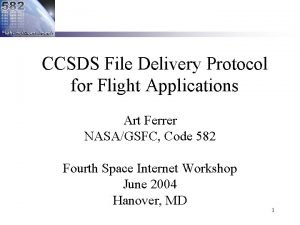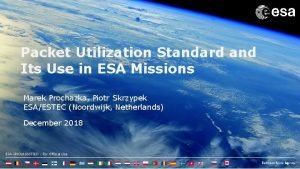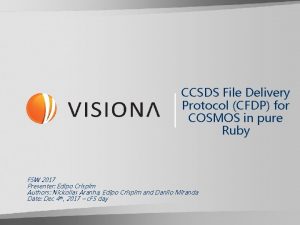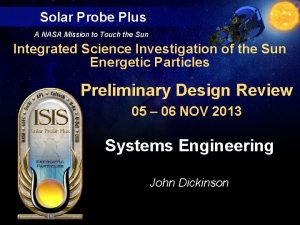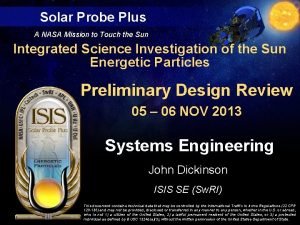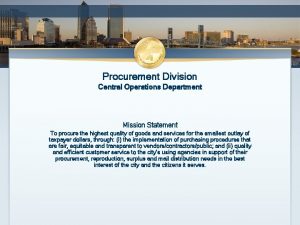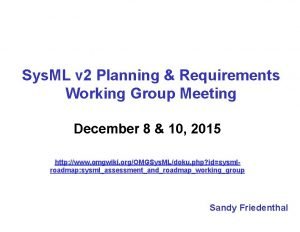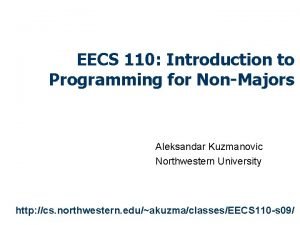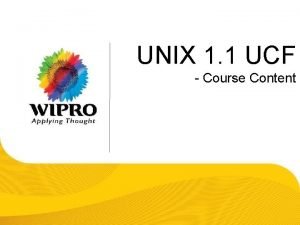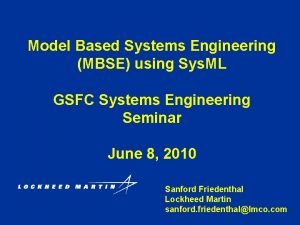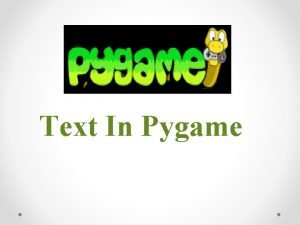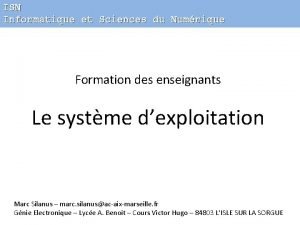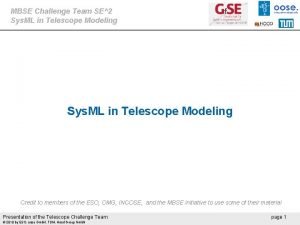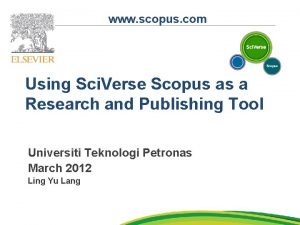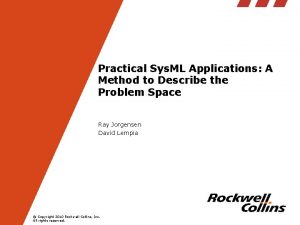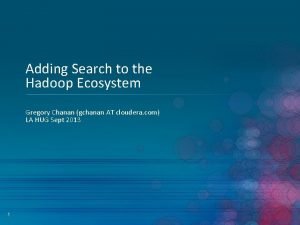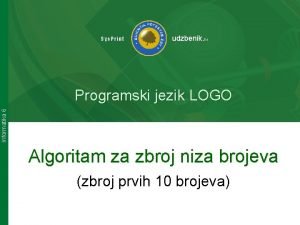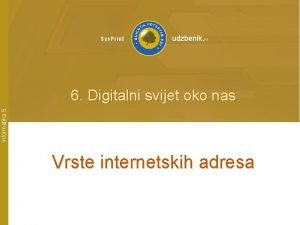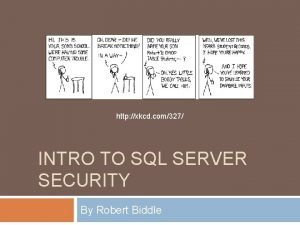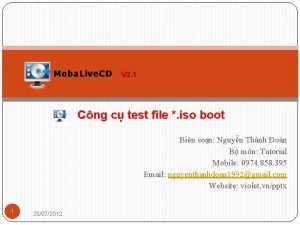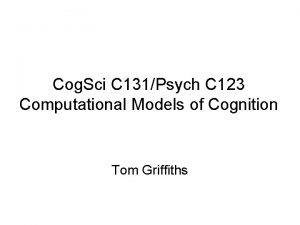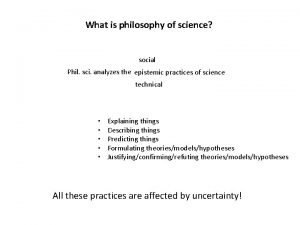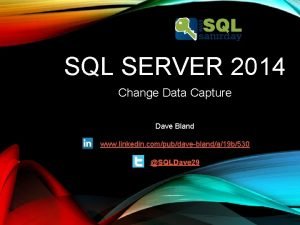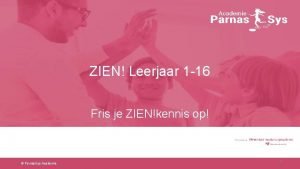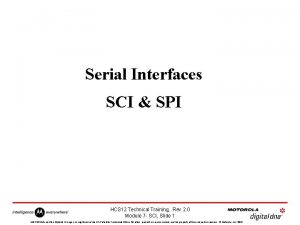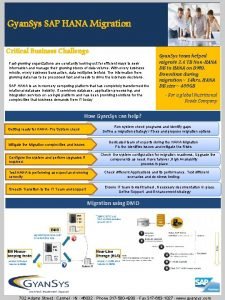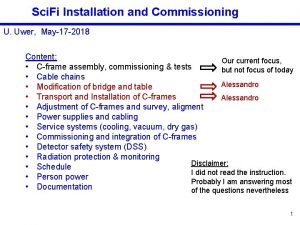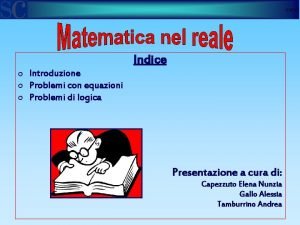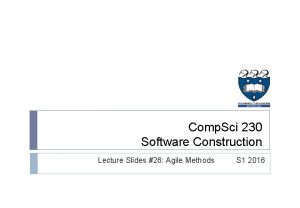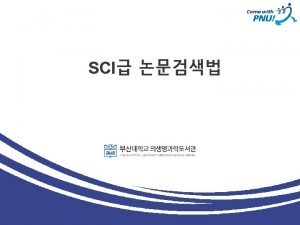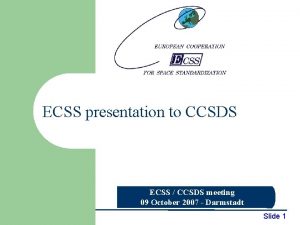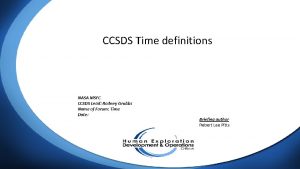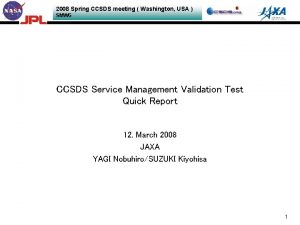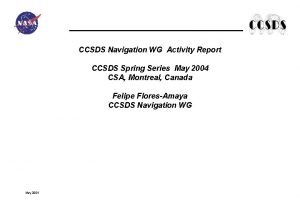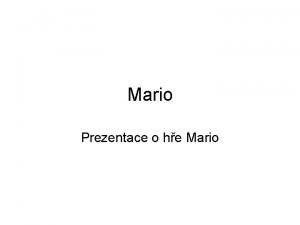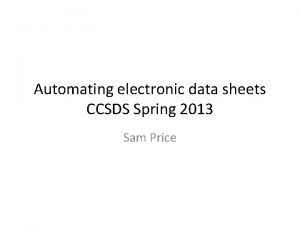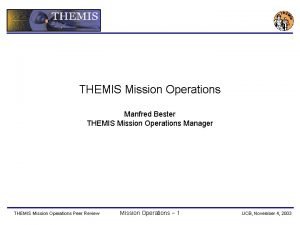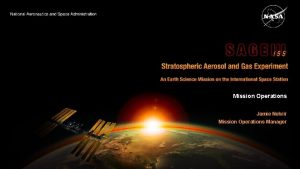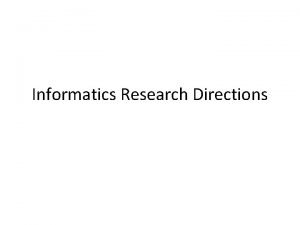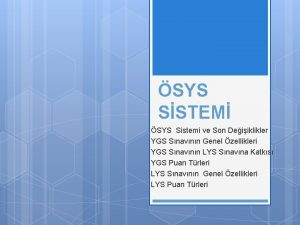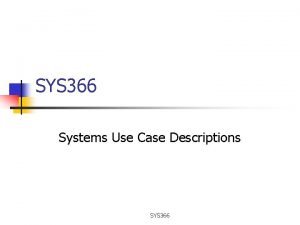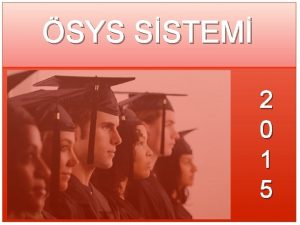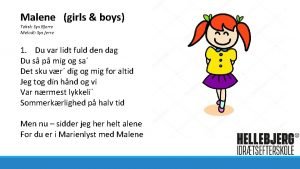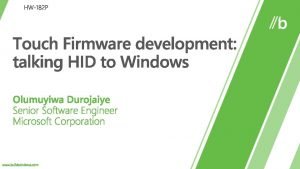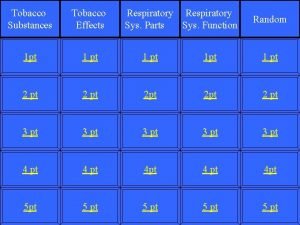CCSDS Mission Operations Sam Cooper Sci Sys Mario














![Candidate MO Services Operationally meaningful information exchange: M&C Status [Monitoring Parameter] Control Directive Event Candidate MO Services Operationally meaningful information exchange: M&C Status [Monitoring Parameter] Control Directive Event](https://slidetodoc.com/presentation_image_h2/6c99ea9cac215eef50cc3e51ce25e43b/image-15.jpg)






















- Slides: 37

CCSDS Mission Operations Sam Cooper (Sci. Sys), Mario Merri (ESA)

Overview Primer Integration with on-board architectures MO Services Mapping to and from PUS Status and Future 2

Primer

Packet Utilisation Standard The PUS continues to serve us well and will also be improved in the next update, However: Only used in Europe Only really extends as far as the edge of the MCS Fixed to CCSDS Space Packets The CCSDS Spacecraft Monitor & Control WG is defining a standard that Extends from the onboard applications right through the ground systems to the end users Is compatible with all CCSDS Agencies With support of standardised architectures such as SAVOIR-FAIRE will provide a single solution for the M&C of any spacecraft by any agency Known as the CCSDS Mission Operations (MO) Services 4

Relationship to PUS MO Services are fundamentally based on PUS Refactored to make them self-consistent and transport independent MO Services expand PUS Services MO Services cover more functions than PUS MO Services improve PUS Services The specifications are independent of transport and encoding technology A Message Abstraction Layer (MAL) ensures this They are design to be used on-ground, on-board and across the spacelink 5

Distributable Mission Operations Functions Spacecraft M&C (Status, Control) Automation (Procedures, Timelines) Planning (Tasks, Goals) Mission Data (Products) Navigation (Orbit, Attitude) On-board Software Payload/Science Team Mission Control Centre Another Agency Mission Operations Services: Spacecraft Manufacturer 6 Organisational Boundaries Functional Boundaries System Boundaries Long-Term Data Persistence

Distributable Mission Operations Functions M&C (Status, Control) Automation (Procedures, Timelines) Planning (Tasks, Goals) Mission Data (Products) Applications Navigation (Orbit, Attitude) AOCS On-board Software System FDIR Mission specific services Plan/ Autonomy Thermal Satellite Mgmt System mode mgmt Power SSMM Mgmt OBT Mgmt P/L Manager Connector services Container services Software bus Abstract component services Libraries: maths, etc. OBCP interpreter MO specific MO TM TC Component services monitoring SOIS DVS Context Mgmt Standardiz Legacy ed devices SOIS MTS SOIS TAS RTOS SOIS Subnetwork layer (1553, CAN, Sp. W) (including HDSW) Solid State Mass Memory CPU Security Unit Sensors & actuators BSP Applic ation Remote Terminal Unit SOIS CAN MIL-1553 RAM SGM OBTimer SOIS ADCs / DACs SOIS Space Linux CPU UART Sp. W EEPROM Boot PROM HW watchdog microcontro ller Digital Sensorbus CPU Payload Computer Onboard Communications H/W (e. g. MIL-STD-1553 B, Space. Wire, CAN RS 422) 7 Payloads & Instruments

Technology Independence Service specifications defined in XML Provides a machine readable version of the service specifications Standardised mappings define transformations from the MAL representation Language mappings for specific programming languages Technology mappings for ‘on-the-wire’ transports/encodings Such as SOIS MTS Private mappings are also supported Mappings are not service specific they work for all services Services are defined in terms of the MAL Mappings are defined in terms of the MAL Code generators can be used to auto-generate service APIs Standard transformations from the XML to languages are defined Allows high level APIs for applications 8

Integration with on-board architectures

Implications of Onboard MO Implementation The layered approach of MO aims to reduce implementation complexity Enables development of components that can be reused To be effective requires Appropriate architecture and infrastructure design Enforcement of policies to strictly adhere to standards But does NOT come at the cost of efficiency Layers are conceptual Code auto-generation can merge layers and optimise code for selected target platform Establishment of a widely accepted and supported reference architecture and API’s for onboard SW does help SAVOIR-FAIRE 10

Current architecture Ground Segment Space Segment MCS OBC PUS Applications PUS Data Handling TM/TC Device Space Network Protocols (e. g. Space Packet) CCSDS Packet Router PUS Packets Space Network Protocols (e. g. Space Packet) Message Transfer, File and Packet Store, Command Data Acquisition, Time Access, and Device Enumeration Services (Proprietary architecture) Essentially proprietary using CCSDS Packets basic ECSS datalink standards Spacecraft Transfer Layer Space Data Link Protocols Space Link 11 Subnetwork Packet Service Subnetwork Memory Access Service Subnetwork Synchronisation Service Onboard Subnetwork Device Discovery Service Subnetwork Test Service

Transitional architecture Ground Segment Space Segment MCS OBC MO Applications PUS Applications Message Abstraction Layer PUS Data Handling MO to PUS adapter TM/TC Device Space Network Protocols (e. g. Space Packet) CCSDS Packet Router PUS Packets Space Network Protocols (e. g. Space Packet) Message Transfer Service File and Packet Store Services Command Data Acquisition Services Time Access Service Device Enumeration Service SOIS CCSDS Packets Spacecraft Transfer Layer Space Data Link Protocols Space Link 12 Subnetwork Packet Service Subnetwork Memory Access Service Subnetwork Synchronisation Service Onboard Subnetwork Device Discovery Service Subnetwork Test Service

Future architecture Ground Segment Standard MO Services MCS Mission MO Services Space Segment OBC MO Applications TM TC AOCS TM TC Power OBT Mgmt SSMM mgmt Power Mode mgmt … … MTL Services Context mgmt Thermal FDIR Message Abstraction Layer TM/TC Device Space Network Protocols (e. g. Space Packet) CCSDS Packet Router MO Messages Space Network Protocols (e. g. Space Packet) Message Transfer Service File and Packet Store Services Command Data Acquisition Services Time Access Service Device Enumeration Service SOIS CCSDS Packets Spacecraft Transfer Layer Space Data Link Protocols Space Link 13 Subnetwork Packet Service Subnetwork Memory Access Service Subnetwork Synchronisation Service Onboard Subnetwork Device Discovery Service Subnetwork Test Service

CCSDS MO Services
![Candidate MO Services Operationally meaningful information exchange MC Status Monitoring Parameter Control Directive Event Candidate MO Services Operationally meaningful information exchange: M&C Status [Monitoring Parameter] Control Directive Event](https://slidetodoc.com/presentation_image_h2/6c99ea9cac215eef50cc3e51ce25e43b/image-15.jpg)
Candidate MO Services Operationally meaningful information exchange: M&C Status [Monitoring Parameter] Control Directive Event Notification Automated Activity Scheduled Timeline or Activity List Planning Request Navigation Trajectory and Pointing Predicted Events Data Products Mission Product Time On-board Software Image Remote Software Identified and prioritised by CCSDS space agencies 15

PUS to MO Service mapping PUS Service 1 Telecommand verification COM / Activity 2 Device command distribution M&C / Action 3 Housekeeping & diagnostic data reporting COM / Status 4 Parameter statistics reporting M&C / Statistics 5 Event reporting COM / Status 6 Memory management Software management 8 Function management Automation 9 Time management Time 11 On-board operations scheduling Scheduling 12 On-board monitoring M&C / Check 13 Large data transfer Data product management 14 Packet forwarding control Remote buffer management 15 On-board storage and retrieval Remote buffer management 17 Test M&C / Action 18 On-board operations procedure Automation 19 Event-action Automation Service only planned by CCSDS, but not yet developed 16 MO Service

MO to PUS Service mapping MO Service PUS Service Monitoring and Control Telecommand verification / Device command distribution / Housekeeping & diagnostic data reporting / Parameter statistics reporting / Event reporting / Function management / On-board monitoring / Test Time management Software Management Memory management Planning Scheduling On-board operations scheduling (subset of MO service) Automation On-board operations procedure (subset of MO service) Event-Action Data product management Large data transfer (subset of MO service) Navigation Remote Buffer management On-board storage and retrieval Packet forwarding control Common Services: Directory, Login, Interaction, Replay, Configuration Service only planned by CCSDS, but not yet developed 17

Proposed MO/PUS Unification Roadmap The timescale of the two standards are very different PUS has a revision ‘C’ due next PUS has a revision ‘D’ due 5 years after that MO is expecting to produce our first version of the M&C service in the next 5 years At this point the two may be able to unify: PUS gets the MO protocol independence MO gets flight proven PUS services This leads to the MO view of the roadmap: PUS updates that do not conflict with future merge PUS MO PUS ‘C’ update period MAL COM PUS ‘D’ update period M&C SSM Others Time Today 18 +1 year +2 years +3 years +4 years +5 years Refactor into MO representation Unified PUS/MO

Status and Future

CCSDS SM&C Working Group 8 year lifetime (started in Dec 2003) ESA lead activity with excellent team work among agencies! 10 Space Agencies actively involved Very active (15 workshops, 60+ telecons) Quite productive (… and ready for more) Green Books 2 published (XTCE, MO) 1 under preparation (XTCE Core) Blue Books 2 published (XTCE, MAL) 3 under finalisation (COM, M&C, Common) 1 under preparation (Space Packet Binding) Magenta Books 1 published (RM) 1 under finalisation (Java API) 2 under preparation (C++ API, XTCE CCSDS) Yellow Books 1 published (MAL testing) White Books several in early draft 20

Prototypes Prototype 1 (ESA/CNES) Goal: validation of MAL specification as required by CCSDS Results: Done! Complete automation of 16840 individual tests, the two implementations interoperated perfectly! Prototype 2 (NASA/JSC) Goal: validation of MAL + M&C & Common services Results: Validity of MAL concept proven (3 different underlined technologies used: SOAP/Java, AMS/C, AMS/Python). Prototype 3 (CNES) Goal: evaluate feasibility of migration of the CNES mission control system infrastructure, Octave, to MO services and performance Results: Migration possible and economically convenient. Performances depends on architecture, but in general satisfactory (14, 000 parameters/s in typical Octave operational configuration) Prototype 4 (Eumetsat) Goal: Stack implications and performances Results: Several configurations (Point-2 -Point, Pub/Sub, packet size, 1 -n clients) and communication technologies (RMI, JMS, AMQP (two broker implementations: Java, C++)) were tested and compared. Performances depend on configuration (range 35, 000 -2, 000 parameters/s). The MAL layer does not add noticeable overhead Prototype 5 (DLR-NASA/JSC) Goal: concept and feasibility of MO interoperability between DLR’s MCS and JSC Simulator. Results: All tests have successfully completed. Overall objective of an interoperability test where DLR monitor and control a Simulated NASA spacecraft was successful. Prototype 6 (CNES) Goal: Validation of the M&C service over CCSDS Space Packets Results: The prototype is still on-going, but so far very successful. Please refer to the paper “Space Packet encoding : Reduce the design effort to zero? ” included in the proceedings of Space. Ops 2010 Prototype 7 (ESA) Goal: Validation of the MAL using Web Services specifications Results: The prototype is still on-going. 21

Prototypes Prototype 8 (NASA/JSC) Goal: Prototype a camera service leveraging the CCSDS integrated protocol stack (MO/AMS/DTN) via the ISS Results: the first step has successfully completed. Many lessons learned about the relevant CCSDS protocols and their use together. Feedback being provided to relevant working groups. ISS DTN Network MO Provider MO Consumer Application/Bridge RS 232 RS 422 CAT 5 Ground DTN (NASA/MSFC) NASA/JSC 22 NASA/JSC

Future developments Implementation 1 (CNES) ISIS is a completely new generic onboard and on ground system based on PUS, SSM, and MO. Specification is expected to start in 2012 with development starting in 2013. Implementation 2 (ESA) Ground SW infrastructure ESOC Service Management Framework will be ported to the MO service framework as soon as it is available. Implementation 3 (ESA) SAT-OPS IOD On-board software Proposal from ESOC to deploy demonstration MO applications on the SAT-OPS In Orbit Demonstrator CDF activity. 23

Future plans The strategy is that a future version of the PUS and MO will unify to form a single coherent standard MO brings a layered, technology agnostic, structure PUS has the flight proven service set Aligned with SOIS specifications Make available reference implementations of MO MAL Java/C++/… MAL Make available auto-generators for: Java C/C++ MS Word CCSDS XTCE … Produce tools that support development of service specifications 24

End

Backup slides

CCSDS Specification Status MO Concept GB (ESA): published MO Reference Model MB (ESA): published MO MAL BB (ESA): published BB: Blue Book GB: Green Book MB: Magenta Book can be downloaded free-of-charge from www. ccsds. org Java API MB (CNES): completed Agency review COM BB (ESA): in Agency review MO M&C Service BB (ESA): Agency review and prototyping commencing Q 1 2012 MO Common Service BB (ESA): Agency review and prototyping commencing Q 1 2012 C++ API MB (NASA/JSC): in preparation CCSDS Space Packet mapping BB (CNES): in preparation (Q 2 2012) CCSDS AMS and DTN mapping BB (NASA/JSC): in preparation 27

Perceived Complexity of the Standard MO concept implies use of multiple layer specifications Implies a relatively high level of abstraction in individual specifications Not easy to see the “full picture” when studying one document Not easy to understand what information is actually included in the data structures transferred With proper infrastructure in place, operators would not need to concern themselves with all details Requires a shift in mindset, which may be difficult and take time It is possible to generate tailored documentation from the XML This is just another output option of the auto-generation tools It can be very PUS like if so desired, it is just a ‘display’ choice 28

Example: An MO Operation … An operation in the MO XML format: 29

Example: An MO Operation … Is used to generate tables in the MO specifications: 30

Example: … in PUS style But it is simple to generate alternate representations from the XML: 31

Onboard Implementation Complexity Auto-generation of interface code from service specifications will help Feasible as MO service specifications provided in XML Use in on-board implementation needs to be considered Pros Minimises errors when frequent changes are made during development lifecycle Auto generation of mission databases and documentation Cons Still requires validation of the generator or generated code This is currently done internally at Sci. Sys for on-board projects using a proprietary technology Standardisation of this would increase the reuse benefits Experience gained from this should be taken into account 32

How is an MO Message built? Software layers Application MO Service Abstract MO Message Header Message Body Operation Body MAL Encoding/Transport Encoding Layer provides Operation header & body MAL header fields On-the-wire representation Transport header fields Operation Body Complete MO Message The more options you can fix the more you can optimise 33

For a fixed encoding… Software layers Application Abstract MO Message Header Message Body MO Service Operation Body MAL Operation Body Software layers Application MO Service using fixed encoding Encoding Transport Operation Body Complete MO Message The more options you can fix the more you can optimise 34

Efficiency of Bandwidth Usage Current MO Service Specifications are considered verbose data structures include a superset of all information data encoding efficiency has been “second priority” CNES are currently defining a mapping of MO to CCSDS Space Packets From the abstract model of MO to an efficient binary encoding Also maps to using CCSDS Space Packets as a transport Uses context information to optimise the information actually carried on the space link The goal is near PUS efficiency 35

Relationship to the Space System Model Plan is to produce an SSM-like specification for system modelling Would closely follow ECSS SSM concepts ECSS SSM model is good but PUS specifics preclude its direct use Currently looking at using XTCE, maybe with extensions XTCE and ECSS SSM are well aligned conceptually Extensions to XTCE may be required to capture the high level system information that an SSM requires 36

Technical Characteristics Initially based on the PUS for service specification but abstracted Services defined in terms of a set of Operations: Each operation is a “conversation” between Consumer and Provider The pattern of the exchange are common to many Operations Generic Interaction Patterns simplify specification Message Abstraction Layer (MAL) provides 6 Patterns: SEND, SUBMIT, REQUEST, INVOKE, PROGRESS, & PUBLISHSUBSCRIBE MAL also gives independence from underlying representation Concerned with information exchange rather than ‘bits and bytes’ 37 Application Service Specification MAL Transport/Encoding
 Ccsds file delivery protocol
Ccsds file delivery protocol Ccsds pus
Ccsds pus Ccsds file delivery protocol
Ccsds file delivery protocol Ccsds
Ccsds Ccsds
Ccsds Operations department mission statement
Operations department mission statement Sys ml
Sys ml Katasys
Katasys Comp sci 110 northwestern
Comp sci 110 northwestern Unix c sys wipro
Unix c sys wipro Sys ml
Sys ml Font pygame
Font pygame Bio sys
Bio sys Systeme d'exploitation
Systeme d'exploitation Challenge sys
Challenge sys Scopuscom
Scopuscom Sys bjerre
Sys bjerre Sys log to cloudera
Sys log to cloudera Sci first for hunters
Sci first for hunters Sys print informatika
Sys print informatika Digitalni udžbenik informatika 6
Digitalni udžbenik informatika 6 Tying
Tying Moba live usb
Moba live usb Encv
Encv Cogsci c131
Cogsci c131 Phil sci
Phil sci Sys.sp_cdc_add_job
Sys.sp_cdc_add_job Parnas
Parnas Characteristic of science fiction
Characteristic of science fiction Parnas sys
Parnas sys Spi vs sci
Spi vs sci Gyan sys
Gyan sys Sci-fi
Sci-fi Una pista da sci lunga 7 km ha tre gradi
Una pista da sci lunga 7 km ha tre gradi Stranger things genres drama
Stranger things genres drama Sci 230
Sci 230 Simple key loader error messages
Simple key loader error messages Sci란
Sci란
